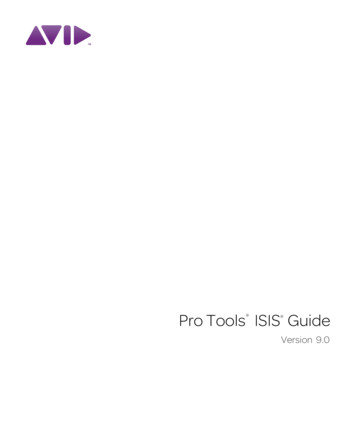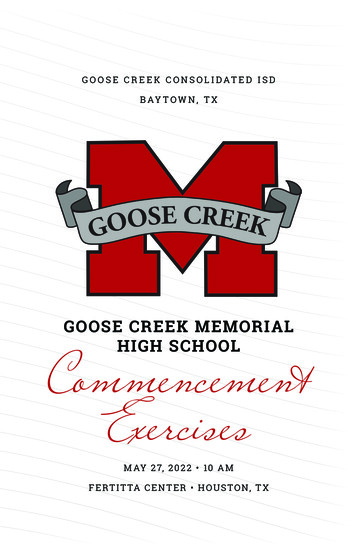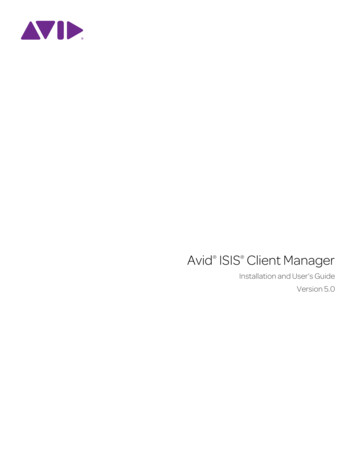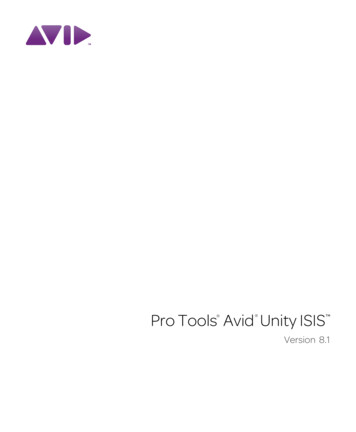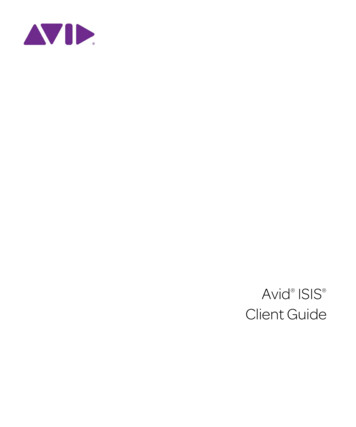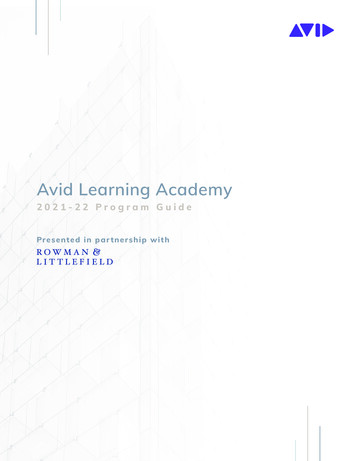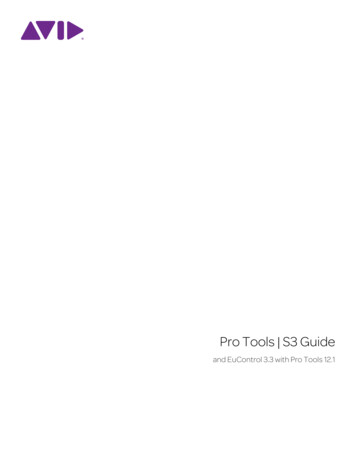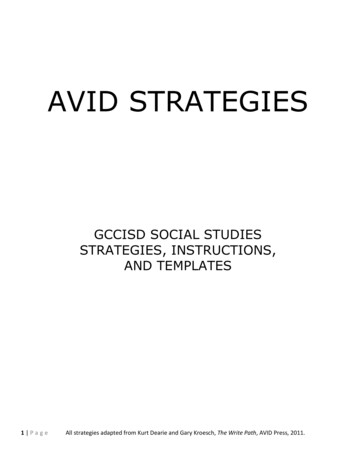
Transcription
AVID STRATEGIESGCCISD SOCIAL STUDIESSTRATEGIES, INSTRUCTIONS,AND TEMPLATES1 PageAll strategies adapted from Kurt Dearie and Gary Kroesch, The Write Path, AVID Press, 2011.
TABLE OF CONTENTSINTERACTING WITH TEXT AND VISUALS – PAGES 3 - 17StrategyPage(s)StrategyCornell Notes4-6Reflective JournalUnderstanding Levels of Questioning7Speculation-Prediction JournalDialectical Journal8Textbook Reading StrategiesMetacognition Journal9StoryboardingProblem-Solution Journal10-11OPTIC for Visual AnalysisREADING FOR UNDERSTANDING – PAGES 18 – 30Strategies for Expository TextIntroducing the TextbookChapter TourAnticipation GuideThink Aloud19Reciprocal Teaching20Question the Author21ReQuest22-23Read, Write, Speak, Listen24Concept MapGRAPHIC ORGANIZERS – PAGES 31 – 38Page(s)1213141516-172526272829-30Graphic Organizers/Thinking Maps32-36Other Graphic OrganizersWRITING TO LEARN/LEARNING TO WRITE – PAGES 39 – 5337-38Pre-Write and Free-Write40Write a Letter to the EditorQuickwrite41Write from Different PerspectivesHistorical Narrative42Primary Source Re-writeSensory Moment in Time43“I” SourceInterviewing a Historical Figure44Writing PoetryWriting an Editorial45ANALYZING PRIMARY SOURCES – PAGES 54 – 634647484954-63ACAPS55—56Create an Editorial CartoonAnalyzing a Photograph57Analyzing Less Traditional SourcesCollaborative Inquiry58Analyzing DataEditorial Cartoon Analysis59Evaluating a WebsiteSTRUCTURED DISCUSSION/ACCOUNTABLE TALK – PAGES 64 – 78GROUPS Acronym65Inner-Outer CirclePreparing Students for Discussion66Socratic SeminarThink, Pair, Share (and variations)67Philosophical ChairsCharacter Corners68DebateFour Corners69Character GroupsFishbowl70ORAL PRESENTATIONS – PAGES 79 – 86TPR (Total Physical Response)VocabularyOral EssayMeeting of the Minds2 Page8081-8283606162637172-747576-7778Reader’s Theater84TableauThe Hot Seat8586All strategies adapted from Kurt Dearie and Gary Kroesch, The Write Path, AVID Press, 2011.
SECTION ONEINTERACTING WITH TEXT OR VISUALS3 PageAll strategies adapted from Kurt Dearie and Gary Kroesch, The Write Path, AVID Press, 2011.
Cornell NotesInstructionsOne Third of the PaperTwo Thirds of the PaperConnections to NotesNotesThis can include: Main ideasStudents take notes here from lecture, reading, video,etc. Vocabulary terms Questions Reflections Reactions Drawings Inferences Opinions Interests Connections to otherevents SignificanceSummary of Most Important Ideas:4 PageAll strategies adapted from Kurt Dearie and Gary Kroesch, The Write Path, AVID Press, 2011.
Cornell NotesTemplateConnections to NotesNotesSummary of Most Important Ideas:5 PageAll strategies adapted from Kurt Dearie and Gary Kroesch, The Write Path, AVID Press, 2011.
Cornell NotesTemplate with LinesConnections to NotesNotesSummary of Most Important Ideas:6 PageAll strategies adapted from Kurt Dearie and Gary Kroesch, The Write Path, AVID Press, 2011.
UNDERSTANDING LEVELS OF QUESTIONINGBloom’sCosta’sSocial Studies involves making judgements about people and events; judge theworth of the deEvaluateJudgeRecommendConvinceOpinionLevel 3Social Studies involves making sense out of a jumble of facts; reshape thecontent/material into a new DesignComposeProposeSpeculateSocial Studies involves figuring out complicated situations; break content/materialdown to understand it ineQuestionCharacterizeInvestigateTell WhySocial Studies involves applying lessons of the past to the present; use whatyou’ve learned to apply the lessons of the past to another time or eIllustrateModelImitateLevel 2Social Studies involves explaining people and events; show that you understandthe facts you’ve anslateSummarizeDescribeReportSocial Studies involves people, events, and dates from the past; recall what youhave learnedRecall7 abelListLevel 1All strategies adapted from Kurt Dearie and Gary Kroesch, The Write Path, AVID Press, 2011.
Dialectical JournalInstructionsStudents divide a piece of paper in half and then copy an important passage, chart,map, photograph (description is fine for a visual) on the left side. On the right side, theyrespond to the text by: Asking a question Analyzing (breaking down the various parts) Interpreting (explaining their view of the meaning) Evaluating (explaining the value) Reflecting (expressing personal thoughts or opinions) Making personal connections Creating a drawing or illustration Relating it to a different text or visual Summarizing the text Predicting the effect2Passage or Quotation fromthe Text or VisualThe text could be a fact, quote, pictureor mapQuote3Text/fact4Picture/graph5Chart18 PageStudent ResponseStudent may make a reaction to thequoteStudent may make an analysis,question, or connectionStudent may ask a question, evaluate,or make a predictionStudent may interpret, question, orsummarizeStudent may question, evaluate, orwrite a reactionAll strategies adapted from Kurt Dearie and Gary Kroesch, The Write Path, AVID Press, 2011.
Metacognition JournalStudents divide a piece of paper in half. On the left, they record “What I Learned” andon the right, they record “How I learned It.” The teacher should indicate how manyexamples should be included for each reading/visual.The metacognition section can include: Explaining what enabled the student to gain the most from the experience Strategies the student used to gain knowledge What the student would do differently if they were able to go back to the projector task1What I LearnedHow I Learned It23459 PageAll strategies adapted from Kurt Dearie and Gary Kroesch, The Write Path, AVID Press, 2011.
Problem-Solution JournalInstructionsProblem-solution journal writing encourages students to interact with a reading, artifact,or visual. It encourages the students to record their thinking about actual solutions toproblems presented, as well as connecting past problems and solutions with presentones.Problem-Solution JournalVersion OneTitle of Source:As you read, identify problems found in the left column. In the right column, identify andexplain solutions. These can be solutions discussed in the reading or solutions that havebeen used in the past for similar situations or solutions you think up on your own.1PROBLEM(S)SOLUTION(S)23410 P a g eAll strategies adapted from Kurt Dearie and Gary Kroesch, The Write Path, AVID Press, 2011.
Problem-Solution JournalVersion TwoTitle of Source:As you read, identify problems found. For each problem, identify at least two possiblesolutions and explain the probable consequences – positive and negative – of eachsolution. Finally, identify and explain the best solution for each problem.Problem:Possible Solution #1Possible Solution #2Possible Solution #3Consequences ofthis SolutionConsequences ofthis SolutionConsequences ofthis SolutionBest Solution and Why:11 P a g eAll strategies adapted from Kurt Dearie and Gary Kroesch, The Write Path, AVID Press, 2011.
Reflective JournalWhat I DidWhat I LearnedQuestions I Still HaveThings that Surprised MeOverall Response12 P a g eAll strategies adapted from Kurt Dearie and Gary Kroesch, The Write Path, AVID Press, 2011.
SPECULATION-PREDICTION JOURNALInstructionsSpeculation-prediction writing allows students to interact with a text, document, visual,internet site, etc. Students consider the events and material and predict the possibleeffects. This strategy helps to develop students’ understanding of the complexity ofcause-and-effect relationships as well as to recognize recurring themes over time.Have students divide their paper in half. On the left side, they will record “WhatHappened” and on the right they will record “What Might/Should Happen as a Result.”Students should be encouraged to think about the “what ifs” and speculate aboutconsequences.What Happened (Facts)1What Might/Should Happen asA Result (Speculation/Prediction)234513 P a g eAll strategies adapted from Kurt Dearie and Gary Kroesch, The Write Path, AVID Press, 2011.
Ideas for Textbook ReadingThere are a number of excellent strategies for helping students interact more deeplywith their textbook – just a few of these are listed below. We encourage teachers to becreative and have students do more than just “read the section and answer thequestions at the end.”Interacting with the Textbook – have students: Turn the titles, headings, and subheadings into question prompts beginning with“explain” or “describe” and then answer those questionsCreate new titles, headings, and subheadings for each section Develop questions from the text, pictures, or data Prepare a graph, chart, or table using information in the text Write a poem about a key idea, term, or character Make inferences (given a fact, what else is probably true?) from the text Provide new examples or make connections to other times in history (either frombefore or later)Write a script or dialogue and role-play the situation or dilemma Evaluate a section in the text by questioning the author’s purpose and credibility Develop “what if” statements from the text, pictures, or data Relate the text to personal experience Compose metaphors or similes for events or issues in the text Create an analogy Make a visual interpretation of the reading using words, symbols, and pictures14 P a g eAll strategies adapted from Kurt Dearie and Gary Kroesch, The Write Path, AVID Press, 2011.
StoryboardingInstructionsStoryboarding is a strategy requiring students to sequence a series of events orconcepts by writing summaries, creating illustrations, and posing questions (rememberto have them use the various levels of questions from Bloom’s or Costa’s). This activityhelps students develop skills in chronological reasoning, summarizing, and causation.Have students divide a piece of paper (poster size is best, but any will work) into thenumber of sections corresponding to the number of sections in a selected chapter orreading. After reading each section, students should: Create a title for that section Write a short summary of the section Create an illustration of the information (this should be the largest portion of thesection) Pose at least one question that is not directly answered in the text (an “I wonder”question)15 P a g eAll strategies adapted from Kurt Dearie and Gary Kroesch, The Write Path, AVID Press, 2011.
OPTIC FOR VISUALSInstructionsOPTIC is a well known strategy for helping students interact with visuals. It worksparticularly well with paintings, photographs, and posters. Please make sure studentsunderstand that they can complete an OPTIC organizer in any order they choose –frequently, it’s easier for students to identify parts before they try to give an OOVERVIEWAs with ALL AVID strategies, this strategy works best when students create their ownversion of the organizer. It is useful to have a template for students to use while initiallylearning the strategy, however, a template also makes students believe that theirresponse is limited to the space given and we obviously want them to give as manyanswers as they can come up with rather than staying inside a box, so we ask teachersto stop using the template as soon as possible after teaching the strategy and encouragestudents to answer each part as completely as possible – sometimes it’s better not todraw the boxes until the answers are complete.16 P a g eStudents give an overview of what they see in the image, what it seems tobe about in a general sense.Students identify all the specific parts of the work, giving details, colors,figures, arrangements, groupings, shadings, patterns, numbers, etc.Students analyze the text (starting with any title or caption, but alsolooking for text within the image). Have them think both literally andmetaphorically for meaning. What does the text suggest and why was itincluded in the image?Have students discuss the interrelationships in the image – both how theparts are related to one another and how they are related to the image as awhole. Consider how all the parts come together to create a mood or toconvey an argument or meaning.Students write a conclusion paragraph about the image as a whole,including analysis of what its creator intended to convey as well as howeffectively it conveys its message and the parts that contribute to thateffectiveness.All strategies adapted from Kurt Dearie and Gary Kroesch, The Write Path, AVID Press, 2011.
OPTICOverviewOWrite a brief overview of the image; in one or more complete sentence(s), what is this image about?PartsPTake note of all the parts in the image – important details, colors, figures, textures, groupings,arrangements, patterns, shadings, numbers, etc. Whichever are relevant to this image.TextTWhat is the title? Is there a caption? What do these tell you about the meaning of the work? Is thereany other text in the image – labels, speech bubbles, signs, etc.? How do they relate to the meaning ormessage of the work?InterrelationshipsISpecify the interrelationships in the image – how are the parts of the image related to each other?How are they related to the image as a whole? How do the parts of the image come together to createa message, mood, meaning, or convey an idea or argument?ConclusionC17 P a g eWrite a brief conclusion paragraph about this image as a whole, including some discussion of thecreator’s intent and how effectively the image conveys its intended meaning or message.All strategies adapted from Kurt Dearie and Gary Kroesch, The Write Path, AVID Press, 2011.
SECTION TWOREADING FOR UNDERSTANDING18 P a g eAll strategies adapted from Kurt Dearie and Gary Kroesch, The Write Path, AVID Press, 2011.
Strategies for Reading Expository TextPrior to the Reading – Establishing a Purpose/Understanding Text StructurePre-read the text by reading title, subtitles, and bold printed words/termsExamine visuals, charts, graphs, and mapsPreview learning outcomes, review questions, and chapter summariesConnect to prior knowledge using KWL chart, media clip, children’s book, tell astory Create a purpose for the reading Learn and retain academic vocabularyDuring the Reading – Monitor Comprehension Teach the organization of the text structure (charting the text) Vary the reading instruction: read aloud, shared reading, choral reading, partnerreading, small group reading, and independent reading Pause to connect ideas within a text Use graphic organizers to understand the reading Mark the text: circle key terms, cited authors, and other essential words ornumbers; underline the author’s claims and other information relevant to thereading purpose Use instructional strategies that improve comprehension: thinking aloud,questioning the source, reciprocal reading, or ReQuest Enrich the content with primary sources Provide varied learning activities: dialectical responses, storyboarding, Cornellnotes, reciprocal reading, questioning the author, pre-writes and quickwrites, andpoetry writingAfter the Reading – Extend ComprehensionSummarize the textDiscuss what you learned or complete a reflective journal responseDesign extension activities, projects, simulations, or performancesPut “social” back in social studies – structured discussions like Socratic Seminar,fishbowl, inner-outer circle, debate, character corners, and four cornersdiscussions19 P a g eAll strategies adapted from Kurt Dearie and Gary Kroesch, The Write Path, AVID Press, 2011.
Introduce the TextbookInstructionsAt the beginning of the instructional year, students benefit from the teacher conductingan introduction to the textbook, explaining how the book is laid out, what its specialfeatures are, and how to navigate the book.Consider the following concepts/ideas: Prefaces, forewords, and introductions give the author(s) a chance to explain whythe book was written and how it is organized – have students read the introductionand explain what it told them about the textbooko This can be done through Read-Think-Pair-Share or some other collaborativeactivityThe Table of Contents provides a “road map” of the textbooko Have students find specific pages, give examples of how to use the Table ofContents, or even use the Table of Contents to find specific pieces ofinformationThe glossary gives definitions of terms used in the textbooko Ask students to find the glossary and find examples of the types of termsincluded and what they meanThe Index provides the fastest means of finding information in the textbooko Give the students three topics covered in the book and have them use theIndex to locate where information about those topics can be foundo Have students discuss and determine the different kinds of fonts used in anindex and what they meanAssign a chapter and have students list all the different ideas that help themunderstand while reading the chapter – be very specifico Pre-questions, objectives, pictures, footnotes, etc.20 P a g eAll strategies adapted from Kurt Dearie and Gary Kroesch, The Write Path, AVID Press, 2011.
Chapter TourInstructionsThis is a frontloading technique used to improve reading comprehension of a chapter ortextbook. The process involves guiding or talking students through a chapter, pointingout features of the text – vocabulary, pictures, charts, graphs, timelines, major ideas orconcepts. This prepares students for successful reading and comprehension.Step OneOrally guide students through the chapter in order to build background knowledge byasking probing questions about each of the following: The Chapter Title – identifies the main idea of the readingSubtitles – present the important concepts, themes, ideas, and events thatsupport the main ideaPhotographs and Illustrations – give visual cues to better understand the contextof the readingCharts and Graphs – give more specific information about ideas in the readingVocabulary Words – must be understood in the context of the readingTimelines – present the order in which events take placeStep TwoHave students create a list or paragraph describing what they know about the main ideaor chapter title.Have them share their list or paragraph with a partner to see if either is missing anyimportant information.Students are now ready to read the chapter.Students may also be assigned to work in pairs to create their own chapter tour afterbecoming familiar with the strategy.21 P a g eAll strategies adapted from Kurt Dearie and Gary Kroesch, The Write Path, AVID Press, 2011.
Anticipation GuideInstructionsAn anticipation guide is a frontloading strategy that forecasts major ideas on a topic orreading and activates thinking about a topic by presenting statements about the mainideas or vocabulary prior to reading a text. This strategy provides a focus for readingand encourages students to be actively involved with the text by anticipating issues thestudents might encounter. The strategy can also be used with visuals.The teacher will write five questions in a questionnaire that students respond to byagreeing or disagreeing with each statement before they read. After completing thereading, students return to the statements in the Anticipation Guide and either reconfirmor change their response and then justify their response by locating evidence in the textto support it.Before Class:1.Read through the selected text you plan to assign to students and develop fourto six statements based on important points or terms.2.Create statements that students can agree or disagree with using the template.During Class1.Hand out the Anticipation Guide and have students agree or disagree with eachstatement in the column that says “Pre-reading.”2.In groups or as a whole class, poll students to see who agrees and disagrees witheach statement – mark the results somewhere visible in the room.3.Give the students the selected text and ask them to read it carefully, markingimportant ideas in their notebook, or highlighting or annotating the text.4.After carefully reading and marking the text, ask students to look at theAnticipation Guide again and mark the Post-reading column.5.Students should search for evidence in the text that supports their claim andthen restate that evidence in their own words (as well as citing the page numberfor the evidence).6.Have a class discussion on the evidence found as well as any continueddisagreement over the statements.*Note – it is difficult in this format for us to provide a template that is easily editable forteachers; however, a simple Google search for Anticipation Guide templates will bring upa variety of forms and templates you can easily modify for your own classroom.22 P a g eAll strategies adapted from Kurt Dearie and Gary Kroesch, The Write Path, AVID Press, 2011.
Anticipation GuideTemplateTitle of Text:Pre-readingAgreeDisagree StatementPost-readingAgreeDisagree Pg. #Restate Evidence in Own Words:Pre-readingAgreeDisagree StatementPost-readingAgreeDisagree Pg. #Restate Evidence in Own Words:Pre-readingAgreeDisagree StatementPost-readingAgreeDisagree Pg. #Restate Evidence in Own Words:Pre-readingAgreeDisagree StatementPost-readingAgreeDisagree Pg. #Restate Evidence in Own Words:Pre-readingAgreeDisagree StatementPost-readingAgreeDisagree Restate Evidence in Own Words:23 P a g eAll strategies adapted from Kurt Dearie and Gary Kroesch, The Write Path, AVID Press, 2011.Pg. #
Think AloudInstructions and IdeasA think aloud models for students the thought process of pausing and connecting, whichis what good readers do while reading difficult and complex text. The teacher verbalizestheir thoughts while orally reading a source, pausing and connecting by “thinkingaloud,” (e.g., questioning the author, recognizing bias, defining vocabulary, clarifying adifficult passage, making predictions, drawing inferences, etc.).Instructions1.Prior to distributing the reading, mark the first third of the selected text withplaces you plan to stop and think aloud (see the list of prompts below for ideasto help choose those places).2.Distribute the text and have students read it.3.Model “thinking aloud” by reading the text and pausing at marked places toverbalize your thinking. Students can take notes on your “think aloud.”4.Direct students to continue the “think aloud” by continuing to read through thetext on their own and mark in the text where they might pause to think andconnect.5.Have students share their work and discuss similarities and differences.List of Prompts for Thinking Aloud I know this word means because The author seems to be suggesting here that This reminds me of I am picturing what this might look like I wonder why I would like to ask the author I wish I knew why This viewpoint seems biased because This part suggests that something else might also be true I can relate to this because I wonder how this connects to This seems very similar to I remember when I really question this because 24 P a g eAll strategies adapted from Kurt Dearie and Gary Kroesch, The Write Path, AVID Press, 2011.
Reciprocal Teaching/ReadingInstructionsReciprocal reading, like a Think Aloud, provides students an opportunity to interact withtext under the guidance of a teacher modeling or providing instruction related to thethings good readers do while grappling with difficult text.This strategy uses five specific skills while reading develop understanding of the text,and part of the strategy involves helping students understand which of the five skills touse at any given point in a text – sometimes all five will be used, sometimes only two,sometimes one is used several times, etc.This is a collaborative activity and can be done whole class with the teaching leading, insmall groups with one reading and the others reacting, or with partners who share theroles.Instructions1.Reader reads aloud, pausing regularly to allow the group or partner to respondusing one of the five skills below.2.Students should share roles, rotating reading and responding responsibilities.Teachers should scaffold this activity by modeling initially, then marking text ahead of time sogroups know when to pause, and gradually releasing responsibility to students.The Five Skills/StrategiesA.B.C.D.E.Predict – using information from the text, make a prediction about what comesnext (either within the text or later); the prediction should be logic-based1.“I predict that ”2.“I wonder why ”Question – developing a question that is directly answered from the text, requiresan inference or evaluation beyond the text, or connects to other text1.“I wonder if ”2.“I’m curious whether ”3.“Why does ”Clarify – this is a process used to clear up confusing parts of the text and mayfocus on an idea, word meaning, or term1.“When I began reading this, I thought now I know ”2.“It would be easier to understand this if it said ”Visual – creating a mental or word-visual to describe the information1.“I can see ”2.“I can picture what this looks like ”3.“I imagine this looking like ”Summarize – summarizing the main ideas presented in the reading; retell thekey points in your own words1.“Another way to say this is ”25 P a g eAll strategies adapted from Kurt Dearie and Gary Kroesch, The Write Path, AVID Press, 2011.
Questioning the AuthorInstructionsThis strategy unfolds a series of queries with the author, helping students understand anauthor’s purpose. Throughout the reading, students engage in a series of questionsabout the credibility of the author’s sources and ideas and decide if the reading isconvincing. Students use the text, their questions, and discussions of possible answersto draw conclusions.Make sure you model this strategy with students before asking them to use it on theirown. Just as with a Think Aloud, students should mark the text to show where theywould pause and ask a question.Questions for the Author Why does the author use this title?What is the author trying to say here?This is what the author says, but what does it really mean?The author uses an interesting example here to make the point Why does the author continue to use this term?How does this connect to ?I may be seeing some bias in the author’s viewpoint This language seems to be biased; I wonder why the author used it?The author cites specific sources as experts, but does the author know who theyare?Does this argument even make sense?I would like to ask the author What information has the author added to this?Are the author’s sources credible? Why/why not?I really question that How does the author stand on this issue? How can I tell?Is the article convincing? Why/why not?26 P a g eAll strategies adapted from Kurt Dearie and Gary Kroesch, The Write Path, AVID Press, 2011.
ReQuestInstructionsReQuest is an interactive reading, inquiry, and discussion activity in which studentsgenerate and request answers to questions they write while engaged in reading. Thisstrategy can be done in pairs, groups, or whole class. The reading can be doneindependently, or as a read-aloud activity in pairs, groups, or teacher-led.Instructions1.Preview the reading with the class by noting title, subtitles, important vocabulary,charts, graphs, maps, and pictures that help build knowledge prior to reading.2.Explain to students that they will be writing higher-order questions (Costa’sLevels 2 and 3) while reading (or listening).3.Model the process of questioning by reading aloud a portion of the text, pausing,and then asking a Level 2 or 3 question.4.Students continue the process by either reading independently and generatingquestions, or listening while a partner or the teacher reads aloud and thendiscussing and generating questions. Have students refer to the UnderstandingLevels of Questioning on Page 7 of this guide and focus on writing Level 2 and3 questions only.5.After reading is complete, students should discuss the questions they havegenerated with a partner or small group. Share with the group why they askedthis question and make a decision about the most interesting or “best” questionto share with the class.6.Have a class discussion over student questions.7.As an exit ticket, have students share what they learned most about the contentin the reading by asking and sharing questions with other students.27 P a g eAll strategies adapted from Kurt Dearie and Gary Kroesch, The Write Path, AVID Press, 2011.
Read, Write, Speak, ListenInstructionsThis cooperative activity provides opportunities for students to read, write, speak, andlisten about specific topics before studying an historical event. This helps buildbackground knowledge and interest about topics to be studied.Instructions1.Select four short high-interest texts about one topic. The text should be no morethen two pages in length.For example, if teaching the Civil War, you might include a reading aboutthe Lincoln Presidency, military strategy, Andersonville Prison Camp, andthe life of a Confederate Soldier2.Arrange students in groups of three or four. Assign each student a different topicto read. Students then read their assigned text.3.After reading, students return to the text and create a list of important and/orinteresting facts to be discussed at the table.4.Each student should be given 3 – 5 minutes to explain their notes about theirreading, while the others in the group take careful notes.5.Each group is given one piece of paper to construct their writing. Begin thewriting process with the first reader’s topic.Reader #1 writes a topic sentence about their readingStudent #2 adds one sentence about the SAME reading to the paragraphStudent #3 adds another sentenceStudent #4 adds another sentenceContinue rotating until time is called or ideas are exhausted.6.The writing process con
WRITING TO LEARN/LEARNING TO WRITE - PAGES 39 - 53 Pre-Write and Free-Write 40 Write a Letter to the Editor 46 Quickwrite 41 Write from Different Perspectives 47 Historical Narrative 42 Primary Source Re-write 48 Sensory Moment in Time 43 "I" Source 49 Interviewing a Historical Figure 44 Writing Poetry 54-63
